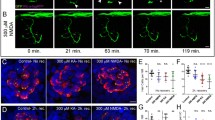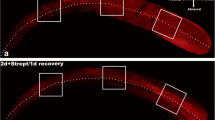Summary
Glutamate (Glu) is the major afferent excitatory neurotransmitter in the auditory system, and excessive Glu may play an important role in cochlear dysfunction. It is unclear how excessive Glu plays roles in cochlear dysfunction in cochlear organotypic cultures. In this study neonatal rat cochlear organotypic cultures were prepared, and then the cochlear tissues were incubated with a new medium containing specific concentrations of Glu (0.1, 0.5, 1, 10 or 20 mmol/L) for 24 h, or incubated with the medium containing a concentration of 20 mmol/L Glu for 6, 12, 24 or 72 h, respectively. It was found that when the cochlear tissues were cultured for 24 h, the inner hair cells (IHCs) were damaged at the concentration of 0.5 mmol/L Glu, and with the increases of the concentrations, the injury was gradually aggravated, and 20 mmol/L Glu resulted in the significant loss of IHCs. In the 20 mmol/L Glu groups, the stereocilia bundles were missing or disarrayed on a few IHCs after culture for 6 h and the damage effect was time-dependent. The missing of IHCs was more significant in the basal turn of the cochlea than in the middle turn of the cochlea under the same concentration of Glu exposure. These results suggest that excessive exogenous Glu affects the morphology of IHCs, but not affects the outer hair cells (OHCs) in cochlear organotypic cultures, and the excitotoxic effects are different on IHCs of different parts of the cochlea under the same concentration of Glu exposure.
Similar content being viewed by others
References
Eybalin M. Neurotransmitters and neuromodulators of the mammalian cochlea. Physiol Rev, 1993,73(1):309–373
Bobbin RP, Thompson MH. Effects of putative transmitters on afferent cochlear transmission. Ann Otol Rhinol Laryngol, 1978,87(1):185–190
Jager W, Goiny M, Herrera-Marschitz M, et al. Sound-evoked efflux of excitatory amino acids in the guinea-pig cochlea in vitro. Exp Brain Res, 1998,121(4):425–432
Kusakari J, Arakawa E, Rokugo M, et al. Effect of kainic acid upon N1 latency. Laryngoscope, 1984,94(10):1365–1369
Puel JL, Pujol R, Ladrech S, et al. Alpha-amino-3-hydroxy-5-methyl-4-isoxazole propionic acid electrophysiological and neurotoxic effects in the guinea-pig cochlea. Neuroscience, 1991,45(1):63–72
Puel JL, Pujol R, Tribillac F, et al. Excitatory amino acid antagonists protect cochlear auditory neurons from excitotoxicity. J Comp Neurol, 1994,341(1):241–256
Pujol R, Puel JL. Excitotoxicity, synaptic repair, and functional recovery in the mammalian cochlea: a review of recent findings. Ann N Y Acad Sci, 1999,884:249–254
Li X, Sun J, Yu N, et al. Glutamate induced modulation of free Ca(2+) in isolated inner hair cells of the guinea pig cochlea. Hear Res, 2001,161(8):29–34
Pujol R, Puel JL, Gervais d’Aldin C, et al. Pathophysiology of the glutamatergic synapses in the cochlea, Acta Otolaryngol. 1993,113(3):330–334
Hyodo J, Hakuba N, Hato N, et al. Glutamate agonist causes irreversible degeneration of inner hair cells. Neuroreport, 2009,20(14):1255–1259
Duan M, Agerman K, Ernfors P, et al. Complementary roles of neurotrophin 3 and a N-methyl-D-aspartate antagonist in the protection of noise and aminoglycoside-induced ototoxicity. Proc Natl Acad Sci U S A, 2000,97(13):7597–7602
Zheng, JL, Gao WQ. Differential damage to auditory neurons and hair cells by ototoxins and neuroprotection by specific neurotrophins in rat cochlear organotypic cultures. Eur J Neurosci, 1996,8(9):1897–1905
Ding D, Stracher A, Salvi RJ. Leupeptin protects cochlear and vestibular hair cells from gentamicin ototoxicity. Hear Res, 2002,164(1–2):115–126
Zheng, XY, Henderson D, Hu BH, et al. Recovery of structure and function of inner ear afferent synapses following kainic acid excitotoxicity. Hear Res, 1997,105(1–2):65–76
Lu H, Wang X, Sun W, et al. New insights into glutamate ototoxicity in cochlear hair cells and spiral ganglion neurons. Acta Otolaryngol, 2010,130(12):1316–1323
Sunami K, Yamane H, Nakagawa T, et al. Glutamate toxicity induced degeneration of outer hair cells with a temporal increase of nitric oxide production in the guinea pig cochlea. Eur Arch Otorhinolaryngol, 1999,256(7):323–329
Sunami K, Yamane H, Takayama M, et al. Cystine protects cochlear outer hair cells against glutamate toxicity. Acta Otolaryngol, 1999,119(6):671–673
Pujol R, Lenoir M, Robertson D, et al. Kainic acid selectively alters auditory dendrites connected with cochlear inner hair cells. Hear Res, 1985,18(1):145–151
Ruel J, Wang J, Rebillard G, et al. Physiology, pharmacology and plasticity at the inner hair cell synaptic complex. Hear Res, 2007,227(1–2):19–27
Sohmer H, Kinarti R. Survey of attempts to use auditory evoked potentials to obtain an audiogram. Review article. Br J Audiol, 1984,18(4):237–244
Author information
Authors and Affiliations
Corresponding authors
Additional information
The authors contributed equally to this work.
This project was supported by grants from National Natural Science Foundation of China (No. 30872858), Research Fund for Doctoral Program of Higher Education of China (No. 200800250006), and Beijing Municipal Natural Science Foundation of China (No. 7082024).
Rights and permissions
About this article
Cite this article
Hu, Y., Zhou, Lq., Lu, Ht. et al. Excitotoxic effects of glutamate on cochlear organotypic cultures. J. Huazhong Univ. Sci. Technol. [Med. Sci.] 35, 117–121 (2015). https://doi.org/10.1007/s11596-015-1399-0
Received:
Revised:
Published:
Issue Date:
DOI: https://doi.org/10.1007/s11596-015-1399-0




